Everything I read on fitness blogs and in trade magazines lately keeps following the same B.S. mantra of "differentiate your gym through customer service." While I agree that excellent customer service should always be a cornerstone of any business, all of these bloggers and writers are ignoring the sea change that’s happing in the industry. If they follow their own advice, they’re going to end up with a small handful of extremely happy members – unfortunately for them, a small group of very happy members won’t pay the bills.
If I had to predict how to properly position your gym for success, I would put my money on the big-box, nice equipment, no-frills, easy pricing model. You can see this model exemplified in the fast growing franchise system Planet Fitness (I have no affiliation with Planet Fitness or any of its franchisees). As far as sales are concerned, they offer two membership options:
1. $10.00 per month with a $29.00 signup fee and a $29.00 annual fee which only allows the member to use the location where they signed up (* and no free tanning)
2. $19.99 per month with no signup fees and an annual fee of $39.00 which allows the member to use any Planet Fitness location and tanning
Planet Fitness gyms feature a generous amount very nice equipment (all powder coated an obnoxious purple and yellow), free personal training, and tanning. They’ve generally removed all of the greatest gym cost centers: group fitness, child care, and water (showers, pools, hot tubs, and saunas). They also don’t have a staff dedicated to sales (read, no costly commissions).
Actual numbers
I’ve been privy to the financial statements of a few Planet Fitness franchisees and here’s how they break down:
20,192 square feet leased for 133 months for a total of $2.6MM (average rent per square foot is 97 cents). Monthly rent works out to $19,586. At the time of writing, this particular gym has just hit 3,500 members paying on average $19.04 per month (including all fees) for a monthly gross total of $60,730. When you subtract the single biggest cost (rent) you have $41,145 per month in income. Obviously you still have to pay all the fixed costs of the business, but I’m quite sure that they still don’t amount to anywhere near that $41k per month. In conclusion, the Planet Fitness model prints cash.
Adapt or die
I’m advocating that you wake up before it’s too late. If you ask 100 members if they would be willing to pay a little more for excellent customer service, 95 of them will emphatically tell you ‘yes!’ However, when it comes time to write the check, those same customers will dump you like a bad relationship for the $10.00 gym down the street. Does it mean that your members are liars? Absolutely not, it simply means that in order to determine what your customers really want, you have to observe how they vote with their wallets.
How do you compete?
I believe that one of the best things you can do in your gym business (in any business) is to continually run real-world experiments. So test my theory out, create a new low cost membership at your gym:
1. Create a new membership option that is sufficiently restricted so that it won’t interfere with your current base (for example, the membership can only be used during off-peak hours)
2. Create a new marketing piece advertising "Prices as low as $9.99 per month!" or whatever you came up with in step 1
3. Measure your response rate and the rate at which you convert these low price leads into memberships
4. In the longer term, measure the attrition rate of these new memberships against the attrition rate of your higher cost offerings
Please don’t write me emails about value selling or the dangers of price selling. We can start to have those conversations again when the economy recovers. Right now, unless you’re in a high income area, you need to price sell, and you need to do it before your competitors do.
*I’m not 100% sure about this, I’ve heard conflicting things

